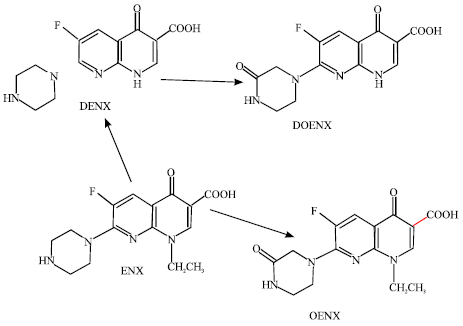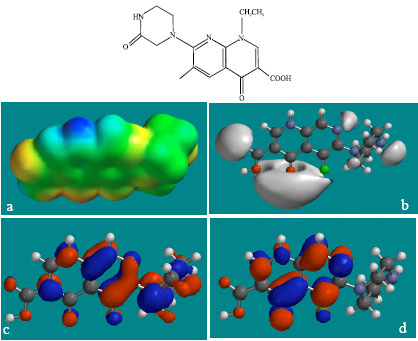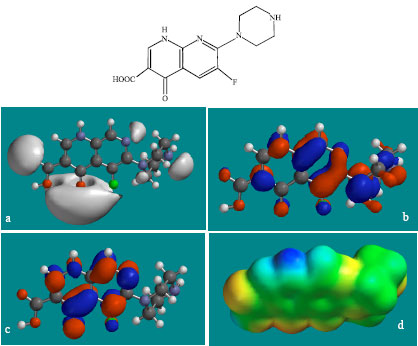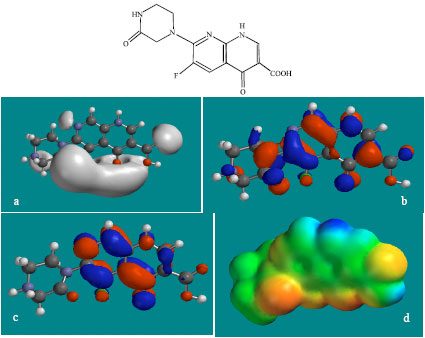Research Article
Molecular Modelling Analysis of the Metabolism of Enoxacin
Discipline of Biomedical Science, School of Medical Sciences, Faculty of Medicine, Cumberland Campus, C42, The University of Sydney, Lidcombe, NSW, Australia
Enoxacin [ENX; 1-ethyl-6-fluoro-1,4-dihydro-4-oxo-7-(1-piperazinyl)-1,8-naphthyridine-3-carboxylic acid) is an orally active fluorinated quinolone antimicrobial agent that has strong activity against both gram-positive and gram-negative bacteria (Naadaiet al., 1990; Pankey 1989). It is effective for the treatment of gonorrhoea, cystis, urinary-tract infections, skin and skin structure infections and is also useful in the treatment of respiratory-tract infections, ear, nose and throat infections. The drug is rapidly and almost completely absorbed after oral administration and is distributed widely in body fluids and tissues (Jaber et al., 1989) and excreted predominantly via the kidney. It has relatively long serum elimination half-life of about 5 h. The most common adverse side-effects of the drug are mild gastrointestinal and central nervous system symptoms.
ENX is a potent inhibitor of cytochrome P450-mediated metabolism of theophylline which is a widely used bronchodilating agent with a narrow therapeutic plasma concentration range (the upper limit of which is associated with adverse cardiovascular and central nervous system effects including life-threatening seizures) (Hoffman and Levy, 1989). The planarity of ENX molecule and the basicity of the 4’-nitrogen atom of ENX are believed to be the dominant factors in the inhibition of theophylline metabolism by cytochrome P450 (Mizuki et al., 1996).
The main metabolite of ENX is 3’-oxo-enoxacin (OENX) formed by oxidation of the 3’-C atom in the piperazine ring to the keto form (Nakamura et al., 1983). Two other metabolites are N-desethylenoxacin (DENX) formed by N-deethylation and oxo-N-desethylenoxacin (DOENX) formed from oxidation of DENX at the 3’ carbon atom. The metabolite OENX is also found to possess some antibacterial activity (about one-tenth of the parent drug).
 | |
| Fig. 1: | Metabolic pathways for ENX |
In this study, molecular modelling analyses have been carried out using the program Spartan ’02 (Spartan 2002) to investigate the relative stability of ENX and its metabolites OENX, DENX and DOENX with the aim of providing a better understanding on their relative toxicity. The study was carried out in the Discipline of Biomedical Science, School of Medical Sciences, The University of Sydney during the months of December 2006 to January 2007.
COMPUTATIONAL METHODS
The geometries of ENX (Fig. 1) and its metabolite OENX, DENX and DOENX have been optimised based on molecular mechanics, semi-empirical and DFT calculations, using the molecular modelling program Spartan ’04. Molecular mechanics calculations were carried out using MMFF force field. Semi-empirical calculations were carried out using the routine PM3. DFT calculations were carried at B3LYP/6-31G* level. In optimization calculations, a RMS gradient of 0.001 was set as the terminating condition. For the optimised structures, single point calculations were carried out to give heat of formation, enthalpy, entropy, free energy, dipole moment, solvation energy, energies for HOMO and LUMO. The order of calculations: molecular mechanics followed by semi-empirical followed by DFT ensured that the structure was not embedded in a local minimum.
To further check whether the global minimum was reached, some calculations were carried out with improvable structures. It was found that when the stated order was followed, structure corresponding to the global minimum or close to that could ultimately be reached in all cases. Although RMS gradient of 0.001 may not be sufficiently low for vibrational analysis, it is believed to be sufficient for calculations associated with electronic energy levels.
Table 1 gives the total energy, heat of formation as per PM3 calculation, enthalpy, entropy, free energy, surface area, volume, dipole moment and energies of HOMO and LUMO as per both PM3 and DFT calculations for ENX and its metabolite OENX, DENX and DOENX. Figures 2-5 give the regions of negative electrostatic potential (greyish-white envelopes) in (a), HOMOs (where red indicates HOMOs with high electron density) in (b), LUMOs in (c) and density of electrostatic potential on the molecular surface (where red indicates negative, blue indicates positive and green indicates neutral) in (d) as applied to the optimised structures of ENX and its metabolite OENX, DENX and DOENX.
| Table 1: | Calculated thermodynamic and other parameters of ENX and its metabolites |
 | |
| Table 1: | Continued |
 | |
| * In atomic units from DFT calculations | |
The calculated solvation energies from PM3 calculations of ENX and its metabolite OENX, DENX and DOENX are respectively -17.26, -24.53, -23.24 and -29.05 and corresponding dipole moments from DFT calculations are 6.2, 7.5, 5.6 and 6.9. The values suggest that ENX and its metabolites would be soluble in water DOENX being most soluble.
The LUMO-HOMO energy differences for ENX and its metabolites from DFT calculations are found to range from 3.8-4.4 eV, indicating that ENX and its metabolites would be moderately inert kinetically. ENX and DENX would be slightly less inert than OENX and DOENX.
In the case of ENX and its metabolites, the electrostatic potential is found to be more negative around the carboxyl and carbonyl oxygen atoms, fluorine atom and pyridine and piperazinyl nitrogen atoms, indicating that the positions may be subject to electrophilic attack.
In the case of ENX and its metabolites OENX, DENX and DOENX, the HOMOs with high electron density are found to be centred on most of ring non-hydrogen atoms and the LUMOs are also found to be close to the non-hydrogen atoms of rings except piperazinyl ring.
The overlap of HOMO with high electron density and region of negative electrostatic potential at some positions, gives further support to the idea that the positions may be subject to electrophilic attack.
The molecular surfaces of ENX and its metabolite OENX, DENX and DOENX are all found to possess neutral (green), negative (yellow and red) and electron-deficient (blue) regions so that they may be subject to lyophilic, electrophilic and nucleophilic interactions. The surfaces of OENX and ENX are found to abound most in electron-deficient regions so that they may be most subject to nucleophilic attacks such as those by glutathione and nucleobases in DNA. Reaction with glutathione will induce cellular toxicity by compromising the antioxidant status of the cell whereas that with nucleobases in DNA will cause DNA damage. ENX being slightly more labile than OENX, the rates of such adverse reactions may be higher in the case of the parent drug.
 | |
| Fig. 2: | Structure of ENX giving in: (a) the electrostatic potential (greyish envelope denotes negative electrostatic potential), (b) the HOMOs, (where red indicates HOMOs with high electron density) (c) the LUMOs (where blue indicates LUMOs) and in (d) density of electrostatic potential on the molecular surface (where red indicates negative, blue indicates positive and green indicates neutral) |
 | |
| Fig. 3: | Structure of OENX giving in: (a) the electrostatic potential (greyish envelope denotes negative electrostatic potential), (b) the HOMOs, (where red indicates HOMOs with high electron density) (c) the LUMOs (where blue indicates LUMOs) and in (d) density of electrostatic potential on the molecular surface (where red indicates negative, blue indicates positive and green indicates neutral) |
 | |
| Fig. 4: | Structure of DENX giving in: (a) the electrostatic potential (greyish envelope denotes negative electrostatic potential), (b) the HOMOs, (where red indicates HOMOs with high electron density) (c) the LUMOs (where blue indicates LUMOs) and in (d) density of electrostatic potential on the molecular surface (where red indicates negative, blue indicates positive and green indicates neutral) |
 | |
| Fig. 5: | Structure of DOENX giving in: (a) the electrostatic potential (greyish envelope denotes negative electrostatic potential), (b) the HOMOs, (where red indicates HOMOs with high electron density) (c) the LUMOs (where blue indicates LUMOs) and in (d) density of electrostatic potential on the molecular surface (where red indicates negative, blue indicates positive and green indicates neutral) |
When surface area and volume of ENX are compared with those of its metabolites, it is found that the values for pharmacologically active metabolite OENX compare most closely with those of ENX (Table 1) suggesting that the two compounds may be able to compete for the same binding site unless precluded by their chemical differences.
ENX is an orally active fluorinated quinolone antimicrobial agent that has strong activity against both gram-positive and gram-negative bacteria. Molecular modelling analyses based on semi-empirical and DFT calculations show that ENX and its metabolites have moderately large LUMO-HOMO energy differences so that none is expected to be highly labile or extremely inert kinetically. ENX and DENX are found to be slightly more labile than OENX and DOENX. Higher lability of ENX and the presence of electron-deficient regions on the molecular surface mean that ENX may react more readily with glutathione and nucleobases in DNA, thus inducing cellular toxicity due to glutathione depletion and DNA damage due to oxidation of nucleobases, respectively.
ABBREVIATIONS
| ENX: | Enoxacin;1-ethyl-6-fluoro-1,4-dihydro-4-oxo-7-(1-piperazinyl)-1,8-naphthyridine-3-carboxylic acid |
| DFT: | Density functional theory |
| LUMO: | Lowest unoccupied molecular orbital |
| HOMO: | Highest occupied molecular orbital |
Fazlul Huq is grateful to the Discipline of Biomedical Science, School of Medical Sciences. The University of Sydney for time release from teaching.